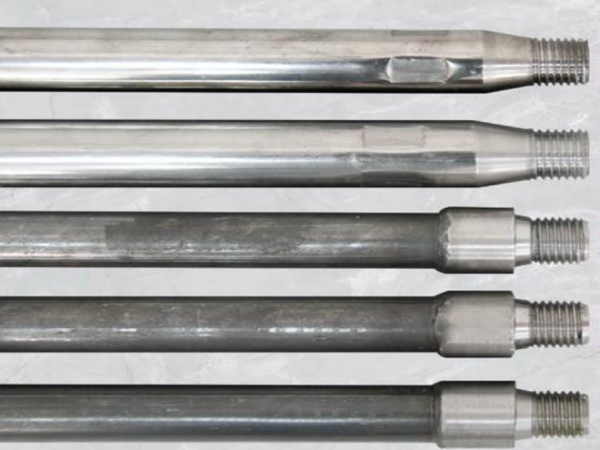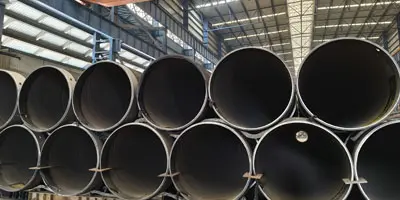What are upset drill pipes and tool joints?
Drill pipe with upset is a specialized type of drill pipe designed to enhance performance and durability during drilling operations. The upset feature, achieved through forging, involves thickening the tube ends, which strengthens the connection points between the pipe body and the tool joints. This structural reinforcement is crucial for handling the stresses encountered in drilling operations.
Manufacturing Process of Drill Pipe with Upset
The production process for upset drill pipes involves precision forging techniques:
Heating the Tube Ends: The ends of the steel tube are heated to the required temperature.
Hydraulic Forging Press: A closed die hydraulic forging press applies pressure, forming the upset ends.
External and Internal Upsetting:
An external upset is formed by increasing the outer diameter at the tube ends while maintaining the internal diameter.
The internal upset process involves using a die to displace material inward, creating a thicker internal wall with a taper.
Internal-External Upset (IEU) combines these methods to reduce the internal diameter and increase the external diameter simultaneously.
This manufacturing process ensures a robust and reliable connection, ideal for high-pressure and high-stress environments.

Tool Joints of Drill Pipe
Tool joints are the enlarged, threaded ends of drill pipes, facilitating connections between individual pipe sections. These joints, produced separately and welded onto the pipe body, are designed for extreme durability. They feature high-strength threads capable of withstanding substantial axial and torsional loads.
Tool Joint Features:
Enhanced thread strength for high-pressure applications.
Improved wear resistance to handle the demanding conditions of drilling operations.
Reliable performance in extreme mechanical and thermal conditions.
Types of Upset Drill Pipes with Tool Joints
Drill pipes are categorized based on the upset configuration at both ends:
Internal Upset (IU):
The internal diameter is reduced while maintaining the external diameter constant.
Provides additional wall thickness for internal stress resistance.
External Upset (EU):
The outer diameter is increased while the internal diameter remains unchanged.
Enhances strength at the external weld area, improving joint performance.
Internal-External Upset (IEU):
Combines IU and EU features by reducing the internal diameter and increasing the external diameter.
Offers superior durability and fatigue resistance.
Advantages of Drill Pipe with Upset
Drill pipes with upset are preferred for several reasons:
Enhanced Weld Area Strength: Thicker walls at the upset regions strengthen the weld joints.
Smoother Transition: Facilitates a gradual transition from rigid tool joints to more flexible pipe bodies, reducing stress concentrations.
Reduced Stress Near Welds: Keeps high-stress zones away from weld regions, minimizing fatigue failure risks.
Heavy Weight Drill Pipe (HWDP)
Heavy weight drill pipe bridges the gap between standard drill pipe and drill collars, offering versatility in drilling operations. Its thicker walls and robust design provide excellent fatigue resistance and stability.
Applications of HWDP:
Cost-Effective Drilling: Minimizes failures in the transition zone, reducing operational costs.
Directional Drilling: Less rigid than drill collars, reducing torque and drag in high-angle or directional wells.
Slim Hole Drilling: Reduced wall contact area decreases the risk of differential sticking.
Transition Zone: Smoothly transitions between drill collars and drill pipes to reduce stress on the drill string.
Other Advantages of HWDP:
Enables high-speed drilling with reduced torque.
Simplifies pipe handling during tripping, as HWDP behaves like standard drill pipe.
Compatible with blowout preventers (BOPs), ensuring safety during operations.
Available in spiral or flush-wall designs for specific applications.
Specifications and Standards
The dimensions and properties of drill pipe with upset and tool joints, as well as heavy weight drill pipes, vary across manufacturers. Typical specifications include:
Outer Diameter (
OD): Varies based on application and design standards.
Wall Thickness: Enhanced in upset regions for added durability.
Length: Standardized for compatibility across drilling systems.
Heavy Weight Drill Pipe Specs:
Diameter and wall thickness tailored to operational requirements.
Wear pads and tool joint lengths optimized for specific drilling conditions.
Drill Pipe Specification with Upset and Tool Joint Chart Abbreviations:
OD – Outside Diameter
ID – Inside Diameter
Nom. Wt – Nominal Weight
Wall Thkns – Wall Thickness
TJ – Tool Joint
The drill pipe specifications with upset and tool joints provides data on the pipe body and tool joints.
The pipe body details include:
Size OD (outer diameter) in inches
Nominal weight in lb/ft
Upset Type (IU, EU, IEU)
Grade which shows the kind of steel, tensile strength, and yield strength
Wall Thickness in inches
Inner diameter (ID) in inches
The tool joint details include:
Connection type or portion of the piping system where joints connect the pipe
Outer and inner diameter configurations
Pin Tong and Box Tong space, which is a usable tong space for pin and box tool joints
Conclusion
Drill pipe with upset and tool joints plays a vital role in modern drilling operations, providing the strength, durability, and flexibility needed to handle challenging conditions. Similarly, heavy weight drill pipes complement these features by offering transitional strength and directional control. Together, these innovations continue to enhance drilling efficiency, safety, and cost-effectiveness in the oil and gas industry.






 English
English Español
Español بالعربية
بالعربية











 Phone :
Phone :  Whatsapp :
Whatsapp :  Email :
Email : 


